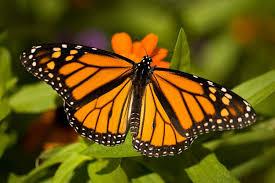Are You Passionate About Pollinators?

Author: Jennifer White, Education Program Coordinator
We are midway through the Portage Park District “Year of the Pollinators”! The warmer weather lures us outside to enjoy our parks, yards, and gardens. This is a wonderful time to learn about our local pollinators and observe them in action on flowering plants.
Ohio is home to approximately 500 native bee species. The term “pollinators” is most often associated with bees; however, birds, butterflies, moths, flies, beetles, and bats are also important pollinators. Our survival is linked to the survival of these animals. Some scientists estimate that one out of every three bites of food we eat exists because of animal pollinators.
Pollinators visit flowers in their search for food (nectar and pollen). During a flower visit, a pollinator may accidentally brush against the flower’s reproductive parts, unknowingly depositing pollen from a different flower. The plant then uses the pollen to produce a fruit or seed. Many plants cannot reproduce without pollen carried to them by foraging pollinators.
The color and form variations of our local pollinators are amazing! Diversity is an indicator of a healthy community, so I encourage you to investigate the pollinator diversity at our Portage Park District properties. Complete our Wild Hikes Challenge (https://www.co.portage.oh.us/portage-county-park-district/things-do/pages/wild-hikes-challenge) to earn your hiking staff and “Year of the Pollinators” medallion. During your hikes, pause to observe the flowering plants along on trails. Who is visiting the blooms? How are they collecting pollen or feeding on nectar? How many kinds of pollinators can you observe on each trail? Watching these beautiful creatures work their magic is a sure way to cultivate your passion for pollinators!
Once you leave the park trails, consider what you can do to grow our local pollinator population.
Every food source and habitat provided can help pollinators rebound from the challenges they face. You can provide food and habitat in your backyard to help pollinators thrive.
Here are five ways to make your garden a haven for native pollinators:
1. Use a range of native flowers in your garden. Native flowering plants that bloom throughout the growing season are beautiful and provide food and shelter. Flowers provide the nectar and pollen resources that pollinators feed on. Choose a mixture of flower colors and shapes to attract a diversity of pollinators. Native plants are undoubtedly the best source of food for pollinators, because plants and their pollinators have coevolved. Growing the right flowers, shrubs, and trees with overlapping bloom times will support pollinators from spring through fall. A plant list for our Great Lakes region can be found here: https://xerces.org/pollinator-conservation/plant-lists/pollinator-plants-great-lakes-region/
2. Avoid using pesticides. Reduce or eliminate pesticide use in your landscape, or incorporate plants that attract beneficial insects for pest control. Insecticides are lethal to pollinators. Herbicides reduce food sources by removing flowers from the landscape. Pesticides reduce available nectar and pollen sources in the garden. To learn more about making informed pesticide choices, visit the Xerces Society Pesticides program page: https://xerces.org/pollinator-conservation/agriculture/managing-pesticides-to-protect-bees/
3. Provide clean water. Pollinators need sources of water for many purposes, including drinking and reproduction. Butterflies will gather and sip at shallow pools, mud puddles or even birdbaths. If you do not have a natural water source, you can create one! Use a shallow dish, bowl or birdbath with half-submerged pebbles for perches. Change the water 2-3 times per week during warm weather when mosquitoes are breeding.
4. Create nest sites. Creating nesting sites for native bees is essential. You can leave patches of bare ground and brush piles, install nesting blocks, or leave dead tree trunk (“snags”) in the landscape. Plant caterpillar host plants to provide food for growing pollinators. This Xerces Society “Nests for Native Bees” factsheet gives information on how to build nest sites: https://xerces.org/wp-content/uploads/2008/10/nest_factsheet1.pdf
5. Be patient with the process. Choosing to support and encourage pollinators in your landscape means that you are playing an active role in developing a healthy ecosystem. Expect and accept that there will be some plant damage on plants meant to provide habitat for butterfly and moth larvae. For more information on making your yard a friendly space for this important group of animals, read the “Attracting Pollinators to the Garden” OSUE fact sheet: https://ohioline.osu.edu/factsheet/ENT-47

